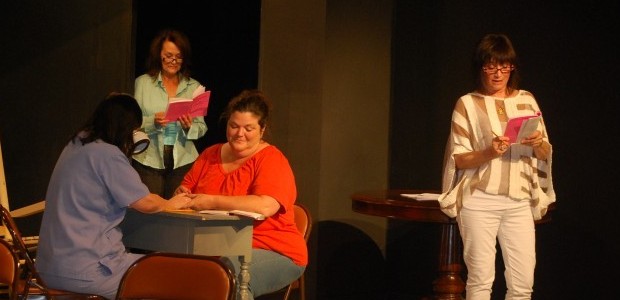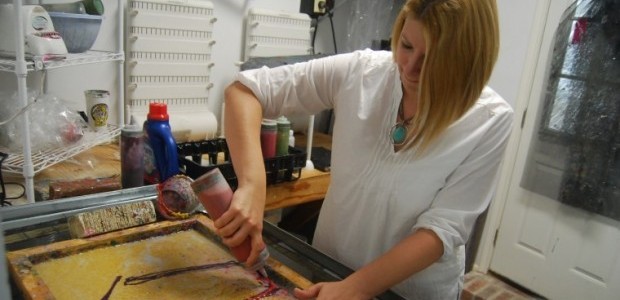
Paddle, ride along La. bayous
April 3, 2012
Southern comedy closes Le Petit’s season
April 3, 2012Hidden beneath the sweater dryers and right beside the boat-motor-powered airplane propeller in Ellen McCord’s cozy art studio are thousands of soggy paper slivers.
These slivers, soaking in a covered bucket, are the matter chosen for McCord’s canvas, as opposed to the brightly pigmented paper fibers in squeeze bottles that are designated to form her depiction’s foundation.
McCord, simply put, paints paper with paper, and the effervescent products have caught the eye of many people, local and not so local. She estimates her work is hanging in more than two dozen states, including Washington, New York and Alaska. “Just the fact that people hang these in their houses makes me smile,” she says.
Like many local artists, the Houma resident prefers to convey south Louisiana culture. Much of her work focuses on local architecture, and she has produced a series of New Orleans staples, such as shotgun houses and a Garden District home. While thumbing through her archives, a few species of bayou wildlife and variations of Fleurs-de-lis, streetcars and brass instruments make appearances, sometimes under star-filled skies.
The pulp-paper painter says she loves the third dimension her method produces. The protruding sections provide texture; so much so that the digital reproductions she sells could be mistaken for originals at a quick glance. She incorporates vibrant hues and describes her style as “whimsical, fun, easy-going, just laissez-faire.”
“I love to be able to use a lot of the colors,” the Thibodaux native says. “I’m a real eclectic person. I put a lot of things together. I love to put surprises in.”
A Nicholls State University graduate with a degree in fine arts, McCord tired of the low reward-to-cost ratio that accompanied her sculpted works and rekindled her love for printmaking when she sold three paintings at an Art After Dark exhibition.
She hasn’t stopped since. The former director of South Louisiana Center for the Arts, McCord has become one of the region’s most recognizable pulp-paper painters.
The boat-motored contraption chops the paper. Ross Jahnke, a print professor at Nicholls who taught McCord the paper-pulp technique, built and traded her the machine – a cheap alternative to Hollander beaters, which produce finer fibers – for some of McCord’s work.
Once the recycled paper is shredded and soaked to an “oatmeal-type substance,” McCord shovels handfuls inside a guiding frame, smoothing the paper and ensuring she has the right density. She then proceeds by squeezing the finer, colored fibers into her base shapes.
After the form of the work is complete, she vacuums the excess water, places the print on a sweater dryer, turns on a fan and allows the work to dry.
A couple days later, she’ll return to give the artwork definition with acrylic paint or chalk pastels. McCord also embeds strings, torn sheet music, wedding reception napkins, wine bottle labels or other natural material, depending on the theme.
Her work features inexact proportions, but that’s not an issue. The flow, coupled with the vibrancy, breathes life into the lucid renderings.
“I really don’t care for anything that’s precise and perfect,” McCord says. “I guess it’s because I’ve learned to embrace the imperfections in myself. I’ve also learned to love the imperfections in art.”
Self-aware and introspective, McCord doesn’t hide that she once trembled over the way her work would be perceived, fretting to the point of self-imposed restriction. The terror culminated with and ceased after McCord’s stern conversation with her reflection.
“I guess sometimes, when dealing with art, you try to fit yourself in a box,” she says. “When I finally figured out that I don’t have a box, I realized I can do what I like and it doesn’t have to be A, B, C. When I finally realized that is when I was able to relax and really enjoy what I do, and other people have enjoyed it, too.”
She prides herself on trying different concepts. She draws some of her inspiration from requests, which she treats as challenges and never refuses, except in the case of book illustrations.
What started as streetcars, musical instruments, and New Orleans architecture has morphed into commissioned paintings of specific homes, churches and even a person.
While specific requests curtail some of her creative obligations, the pressure to meet expectations weighed on McCord the first couple of times she took these jobs. Her style – whimsical, imprecise and imperfect – isn’t necessarily the best method for a rigid replication.
Well, that’s what she thought. “I was scared to death – scared to death,” McCord recalls. Her refusal to rebuff the challenge opened the door, and perseverance yielded her talented renderings.
After the third commissioned painting, the switch was flipped, and beliefs contrary to the notion that people requested her work because of the style she employs began to dissolve.
“I came to the realization they like my work,” she says. “I had to tell myself in the mirror, ‘They like your work. Just relax. They’re not asking you to paint something like someone else. They want it like you do it.’ It was tough. It was a total mental block.”
She has now completed at least 25 paintings commissioned for replication. This list includes a seafood retailer on West Park Avenue in Houma, a hair salon, an assortment of houses and fishing camps, the original Raising Cane’s restaurant (for the owner) and St. Matthew’s Church in Houma before it burned down.
The St. Matthew’s production garnered an abundance of interest after the blaze, so McCord circulated a flier with price listings for the painting’s prints and dedicated a third of the proceeds to the church. She says she donated nearly $1,000 from the print sales.
The mother of two girls – a 9-month-old and 10-year-old – McCord has had to scale back her production. At her peak, she can produce up to 12 paintings a week, she says, but that’s been lessened as she resumes infant motherly duties.
Looking ahead, McCord says she wants to focus on more abstract work and simple landscapes. Her work is on display for the monthly Art Market of New Orleans on April 21 at Palmer Park.
– editor@gumboguide.com
Ellen McCord, a pulp-paper painter, demonstrates her technique. McCord recently painted a musical piece that became the cover art for Nicholls State University’s Jubilee Festival brochures.
McCord’s depiction of St. Matthews Church, which she completed before the Houma icon burned down more than one year ago.










